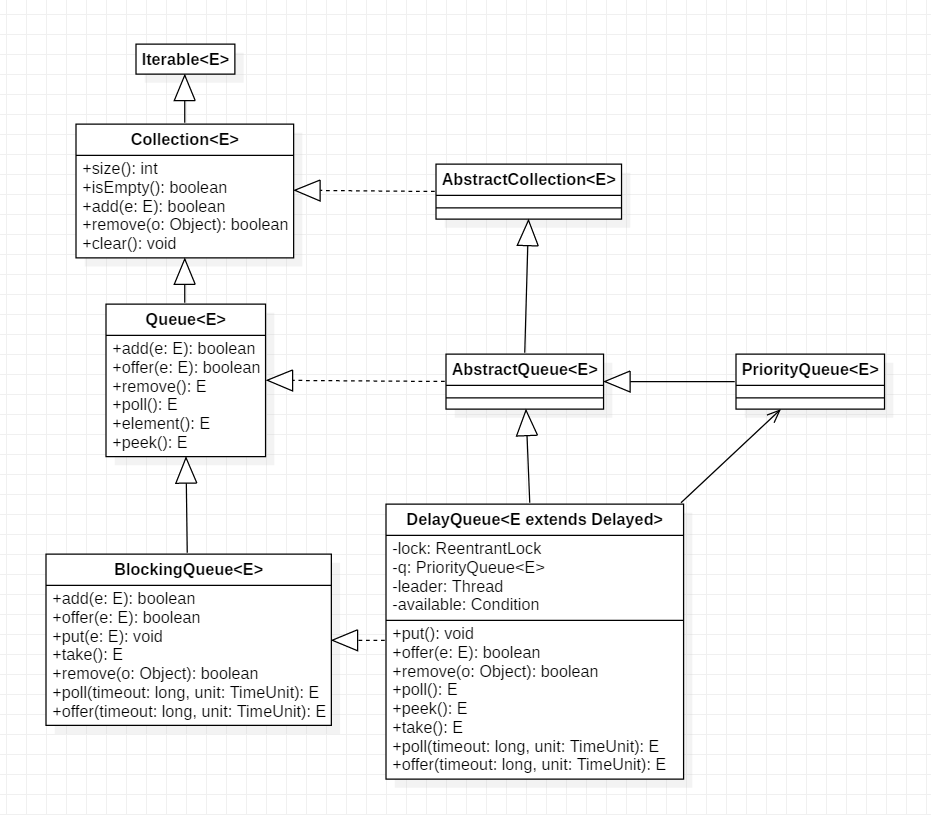Java并发队列原理剖析
来源:https://github.com/afkbrb/java-concurrency-note
LinkedBlockingQueue和ArrayBlockingQueue比较简单,不进行讲解了。下面只介绍PriorityBlockingQueue和DelayQueue。
PriorityBlockingQueue
PriorityBlockingQueue是带优先级的无界阻塞队列,每次出队都返回优先级最高或最低的元素。内部使用二叉堆实现。
类图结构

PriorityBlockingQueue内部有一个数组queue,用来存放队列元素。allocationSpinLock是个自旋锁,通过CAS操作来保证同时只有一个线程可以扩容队列,状态为0或1。
由于这是一个优先队列,所以有一个comparator用来比较元素大小。
下面为构造函数:
private static final int DEFAULT_INITIAL_CAPACITY = 11;
public PriorityBlockingQueue() {
this(DEFAULT_INITIAL_CAPACITY, null);
}
public PriorityBlockingQueue(int initialCapacity) {
this(initialCapacity, null);
}
可知默认队列容量为11,默认比较器为null,也就是使用元素的compareTo方法进行比较来确定元素的优先级,这意味着队列元素必须实现Comparable接口。
原理讲解
boolean offer()
public boolean offer(E e) {
if (e == null)
throw new NullPointerException();
// 获取独占锁
final ReentrantLock lock = this.lock;
lock.lock();
int n, cap;
Object[] array;
// 扩容
while ((n = size) >= (cap = (array = queue).length))
tryGrow(array, cap);
try {
Comparator<? super E> cmp = comparator;
if (cmp == null)
// 通过对二叉堆的上浮操作保证最大或最小的元素总在根节点
siftUpComparable(n, e, array);
else
// 使用了自定义比较器
siftUpUsingComparator(n, e, array, cmp);
size = n + 1;
// 激活因调用take()方法被阻塞的线程
notEmpty.signal();
} finally {
// 释放锁
lock.unlock();
}
return true;
}
流程比较简单,下面主要看扩容和建堆操作。
先看扩容。
private void tryGrow(Object[] array, int oldCap) {
// 由前面的代码可知,调用tryGrow函数前先获取了独占锁,
// 由于扩容比较费时,此处先释放锁,
// 让其他线程可以继续操作(如果满足可操作的条件的话),
// 以提升并发性能
lock.unlock();
Object[] newArray = null;
// 通过allocationSpinLock保证同时最多只有一个线程进行扩容操作。
if (allocationSpinLock == 0 &&
UNSAFE.compareAndSwapInt(this, allocationSpinLockOffset,0, 1)) {
try {
// 当容量比较小时,一次只增加2容量
// 比较大时增加一倍
int newCap = oldCap + ((oldCap < 64) ?(oldCap + 2) : (oldCap >> 1));
// 溢出检测
if (newCap - MAX_ARRAY_SIZE > 0) {
int minCap = oldCap + 1;
if (minCap < 0 || minCap > MAX_ARRAY_SIZE)
throw new OutOfMemoryError();
newCap = MAX_ARRAY_SIZE;
}
if (newCap > oldCap && queue == array)
newArray = new Object[newCap];
} finally {
// 释放锁,没用CAS是因为同时最多有一个线程操作allocationSpinLock
allocationSpinLock = 0;
}
}
// 如果当前线程发现有其他线程正在对队列进行扩容,
// 则调用yield方法尝试让出CPU资源促使扩容操作尽快完成
if (newArray == null)
Thread.yield();
lock.lock();
if (newArray != null && queue == array) {
queue = newArray;
System.arraycopy(array, 0, newArray, 0, oldCap);
}
}
下面来看建堆算法
private static <T> void siftUpComparable(int k, T x, Object[] array) {
Comparable<? super T> key = (Comparable<? super T>) x;
while (k > 0) {
// 获取父节点,设子节点索引为k,
// 则由二叉堆的性质可知,父节点的索引总为(k - 1) >>> 1
int parent = (k - 1) >>> 1;
// 获取父节点对应的值
Object e = array[parent];
// 只有子节点的值小于父节点的值时才上浮
if (key.compareTo((T) e) >= 0)
break;
array[k] = e;
k = parent;
}
array[k] = key;
}
如果了解二叉堆的话,此处代码是十分容易理解的。关于二叉堆,可参看《数据结构之二叉堆》。
E poll()
public E poll() {
final ReentrantLock lock = this.lock;
lock.lock();
try {
// 出队
return dequeue();
} finally {
lock.unlock();
}
}
private E dequeue() {
int n = size - 1;
if (n < 0)
return null;
else {
Object[] array = queue;
E result = (E) array[0];
// 获取尾节点,在实现对二叉堆的下沉操作时要用到
E x = (E) array[n];
array[n] = null;
Comparator<? super E> cmp = comparator;
if (cmp == null)
// 下沉操作,保证取走最小的节点(根节点)后,新的根节点仍时最小的,二叉堆的性质依然满足
siftDownComparable(0, x, array, n);
else
// 使用自定义比较器
siftDownUsingComparator(0, x, array, n, cmp);
size = n;
return result;
}
}
poll方法通过调用dequeue方法使最大或最小的节点出队并将其返回。
下面来看二叉堆的下沉操作。
private static <T> void siftDownComparable(int k, T x, Object[] array, int n) {
if (n > 0) {
Comparable<? super T> key = (Comparable<? super T>)x;
int half = n >>> 1;
while (k < half) {
// child为两个子节点(如果有的话)中较小的那个对应的索引
int child = (k << 1) + 1;
Object c = array[child];
int right = child + 1;
// 通过比较保证child对应的为较小值的索引
if (right < n &&
((Comparable<? super T>) c).compareTo((T) array[right]) > 0)
c = array[child = right];
if (key.compareTo((T) c) <= 0)
break;
// 下沉,将较小的子节点换到父节点位置
array[k] = c;
k = child;
}
array[k] = key;
}
}
同上,对下沉操作有疑问的话可参考上述文章。
void put(E e)
调用了offer
public void put(E e){
offer(e);
}
E take()
take操作的作用是获取二叉堆的根节点元素,如果队列为空则阻塞。
public E take() throws InterruptedException {
final ReentrantLock lock = this.lock;
// 阻塞可被中断
lock.lockInterruptibly();
E result;
try {
// 队列为空就将当前线程放入notEmpty条件队列
// 使用while循环判断是为了避免虚假唤醒
while ( (result = dequeue()) == null)
notEmpty.await();
} finally {
lock.unlock();
}
return result;
}
DelayQueue
DelayQueue并发队列是一个无界阻塞延迟队列,队列中的每一个元素都有一个过期时间,当从队列中获取元素时只有过期元素才会出列。队列头元素是最快要过期的元素。
类图结构

DelayQueue内部使用PriorityQueue存放数据,使用ReentrantLock实现线程同步。
队列里的元素要实现Delayed接口(Delayed接口继承了Comparable接口),用以得到过期时间并进行过期时间的比较。
public interface Delayed extends Comparable<Delayed> {
long getDelay(TimeUnit unit);
}
available是由lock生成的条件变量,用以实现线程间的同步。
leader是leader-follower模式的变体,用于减少不必要的线程等待。当一个线程调用队列的take方法变为leader线程后,它会调用条件变量available.waitNanos(delay)等待delay时间,但是其他线程(follower)则会调用available.await()进行无限等待。leader线程延迟时间过期后,会退出take方法,并通过调用available.signal()方法唤醒一个follower线程,被唤醒的线程会被选举为新的leader线程。
原理讲解
boolean offer(E e)
public boolean offer(E e) {
final ReentrantLock lock = this.lock;
lock.lock();
try {
// 添加新元素
q.offer(e);
// 查看新添加的元素是否为最先过期的
if (q.peek() == e) {
leader = null;
available.signal();
}
return true;
} finally {
lock.unlock();
}
}
上述代码首先获取独占锁,然后添加元素到优先级队列,由于q是优先级队列,所以添加元素后,调用q.peek()方法返回的并不一定是当前添加的元素。当如果q.peek() == e,说明当前元素是最先要过期的,那么重置leader线程为null并激活available条件队列里的一个线程,告诉它队列里面有元素了。
E take()
获取并移除队列里面过期的元素,如果队列里面没有过期元素则等待。
public E take() throws InterruptedException {
final ReentrantLock lock = this.lock;
// 可中断
lock.lockInterruptibly();
try {
for (;;) {
E first = q.peek();
// 为空则等待
if (first == null)
available.await();
else {
long delay = first.getDelay(NANOSECONDS);
// 过期则成功获取
if (delay <= 0)
return q.poll();
// 执行到此处,说明头元素未过期
first = null; // don't retain ref while waiting
// follower无限等待,直到被唤醒
if (leader != null)
available.await();
else {
Thread thisThread = Thread.currentThread();
leader = thisThread;
try {
// leader等待lelay时间,则头元素必定已经过期
available.awaitNanos(delay);
} finally {
// 重置leader,给follower称为leader的机会
if (leader == thisThread)
leader = null;
}
}
}
}
} finally {
if (leader == null && q.peek() != null)
// 唤醒一个follower线程
available.signal();
lock.unlock();
}
}
一个线程调用take方法时,会首先查看头元素是否为空,为空则直接等待,否则判断是否过期。
若头元素已经过期,则直接通过poll获取并移除,否则判断是否有leader线程。
若有leader线程则一直等待,否则自己成为leader并等待头元素过期。
E poll()
获取并移除头过期元素,如果没有过期元素则返回null。
public E poll() {
final ReentrantLock lock = this.lock;
lock.lock();
try {
E first = q.peek();
// 若队列为空或没有元素过期则直接返回null
if (first == null || first.getDelay(NANOSECONDS) > 0)
return null;
else
return q.poll();
} finally {
lock.unlock();
}
}
int size()
计算队列元素个数,包含过期的和未过期的。
public int size() {
final ReentrantLock lock = this.lock;
lock.lock();
try {
return q.size();
} finally {
lock.unlock();
}
}
最近给大家找了 百万级电商
资源,怎么领取?
扫二维码,加我微信,回复:百万级电商
注意,不要乱回复 没错,不是机器人 记得一定要等待,等待才有好东西
